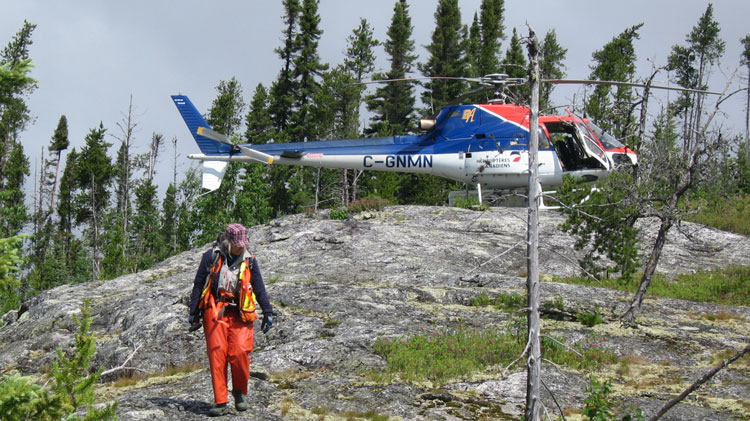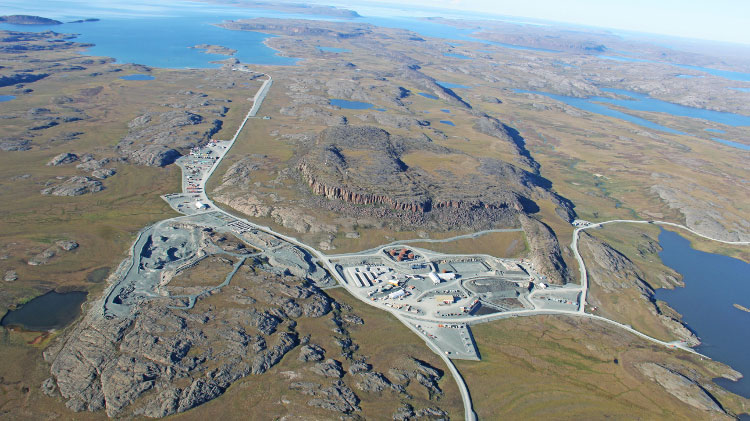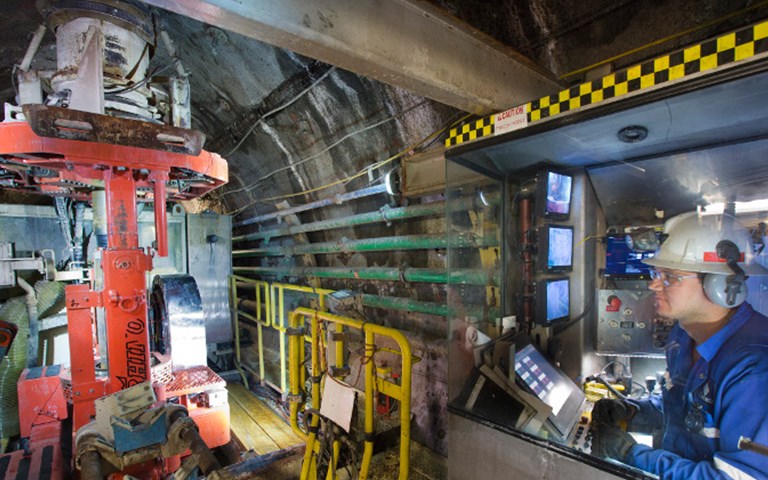When the mine achieves full production, the mining team expects to have two jet boring machines mining the deposit at one time, while two more are either undergoing maintenance, being relocated or working on backfilling. Courtesy of Cameco Corp.
The mine, operated and 50 per-cent-owned by Cameco, was originally slated to open in 2007 at a cost of $450 million. (Areva, which owns and operates McClean Lake, also has a 37 per cent stake in Cigar Lake.) Setbacks, largely related to water inflows in one of the most challenging geologies ever mined, had repeatedly pushed construction timelines back and propelled costs skyward, to more than $2.6 billion.
But through it all, Cameco personnel say they believed in the project, and especially in their team’s ability to persevere and conquer the technical difficulties. “The challenges were always there,” says Bob Steane, senior vice-president and chief operating officer of Cameco, “but we became better at understanding and assessing the challenges. We never reached a point where we thought this isn’t going to succeed.”
The project certainly had its doubters outside the company, especially after the mine completely flooded for a second time during construction. Although the ore body was highly coveted – it was the largest undeveloped high-grade uranium deposit known in the world – the difficult geology was also unparalleled. The deposit, with proven and probable reserves of 217 million pounds of U3O8 at an average grade of 18 per cent, sits in a clay halo in a water-saturated sandstone area of the Athabasca Basin that rests on basement rock that is also not particularly competent.
On the heels of the first major inflow in 2006, the company spent two years sealing the inflow source and then dewatering the mine for recovery, making sure to lower the water level slowly and deliberately to avoid a sudden depressurization. But then in August 2008, with little warning and before the mine was completely pumped out, Cigar Lake catastrophically flooded again. “There was another inflow – from where, we didn’t know,” recalls Steane. “All we knew was that our mine was full again, but it didn’t come from where we had just sealed.” The sudden inflow submerged and ruined much of the underground infrastructure in place at the time – roughly 20 per cent of the final facilities – including electrical equipment, wiring, and freeze systems.
“I had just stepped off a plane in Kazakhstan and (then- COO, now CEO and president) Tim Gitzel phoned to tell me what was happening,” recalls Steane. “That was a discouraging moment. But the key word is that it was a moment. After that, it was, ‘OK, what do we do now?’ And the team buckled down.”
Assurance of success
Driving the project team, which numbered about 50 employees in 2008, was a philosophy that Steane repeats regularly during our conversation. “Starting in 2007, we had adopted an ‘assurance of success’ view,” he says. The philosophy embraces the importance of contingency planning in such a difficult project. The team analyzed all the actions they planned to take, assessed the potential consequences, and developed mitigation strategies for negative possibilities. After the inflow in 2008, the team was compelled to expand the scope of its contingency planning. Where the company had previously identified higher-risk areas and implemented water management strategies accordingly, the new attitude expected the potential for water everywhere in the mine with equal likelihood. That meant an entirely new approach to water management. Gone were the bulkhead doors in high-risk areas that formed the core of the old strategy. If water could come from anywhere in this geological setting, it had to be actively managed, not just reacted to.
The result was a water management strategy and infrastructure including pumps, pipes and treatment capacity that would handle any possible in-flow without flooding the mine. This allows for water remediation from in the mine, without having to retreat to surface again. Based on modelled peak inflows, backed by actual data from the 2006 inflow, Cameco was able to design its systems to match and exceed the worst-case scenario. Four permanent Flowserve dewatering pumps are supplemented by five contingency dewatering pumps and four Baker Hughes submersible borehole pumps, for a nominal total of 2,300 cubic metres per hour. “We have a lot of redundant contingency water pumping capacity,” says Steve Lowen, the general manager of Cigar Lake. The team also initiated a more robust probe and grout program, together with more detailed geological mapping ahead of any development.
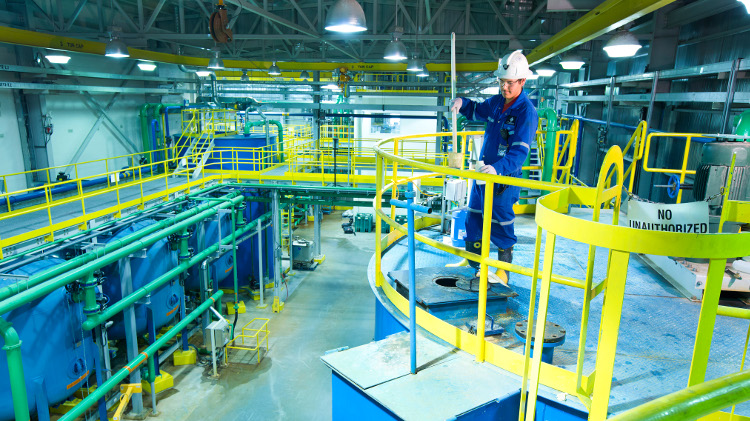 The mine will employ around 600 people when it reaches full production. Courtesy of Cameco Corp.
The mine will employ around 600 people when it reaches full production. Courtesy of Cameco Corp.
Cigar Lake also adopted and expanded a ground freezing program to support ore mining. “Ground freezing was actually one of the original strategies here,” says Lowen. “It was in fact the only way we could mine the ore body.
“What’s unique to Cigar is that instead of using freezing as simply a wall to prevent water inflow, we’re using it to bulk-freeze the entire ore body. That’s both to prevent water inflow, but also to create enough structural stability in the ore body area so that we can use our jet-boring system effectively,” says Lowen. The surface freeze active zone, which is continually expanding for future requirements, currently measures an immense 120m x 80m x 60m, totalling 576,000 cubic metres of frozen ore, clay, and sandstone.
Flexibility and innovation
The third prong of Cameco’s post-inflow approach was changing how they worked with the local geology by adjusting their ground support methods. Previously, the company had used a rigid system of cross-cut supports and high-strength concrete segments when developing in the challenging geological environment under the ore zone. The natural movement of the ground, however, was putting stress on the rigid segments faster than expected, thus shortening the expected life of the developments. They then decided to change the ground support system to one that was more flexible. This meant adopting the New Austrian Tunnelling method, which uses a quick application of shotcrete, and installation of flexible ground support and lattice girders that can adjust to the movement of the ground, while still ensuring stability for the tunnel. “We knew that ground squeezing and flexing were forever and a day going to be part of the Cigar Lake operation,” Steane explains. “The new system provided the necessary ground support, but as things changed and moved, we could deal with it and remediate it.”
That flexibility may as well be a metaphor for how the team approached all the project’s challenges after the 2008 inflow. Under the guiding principle of “assurance of success” – and with nearly $7.6 billion worth of uranium (at the April spot price of US$35/lb) to motivate them – the Cigar Lake team took ideas and innovations from anywhere they could to ensure successful construction.
To locate the second leak, for example, the team improved on a method they had used after the first inflow. They deployed small robotic submarines – remotely operated vehicles (ROV) – to operate in the cold, dark water. The ROVs used ultrasonic technology that gave the operators the vision to see underwater and guide them through the underground workings. Sensitive flow, pH and temperature detectors were fitted to the ROVs, providing information that ultimately pointed toward the source of the inflow. The inflow source contained water that was a bit cooler and lower in pH than the static water in the mine. After locating the leak, a six-by-two-inch hole in the ceiling of a drift, the ROVs became the hands of the operators, moving debris to clear a space in the drift. Finally, an ROV carried a large inflatable bag down into the drift. The bag was carefully placed, then inflated with concrete, permanently sealing the drift and allowing dewatering to commence.
Culture of determination
It takes a certain kind of person to keep coming back to tackle tremendous challenges in the face of repeated setbacks and complications. The team at Cigar Lake, which included many Saskatchewanbased engineers and geologists, met the ongoing problems with gusto. “These are the types of people that would do that good of a job wherever they were working,” Steane says proudly. “They are committed, dedicated people.”
“The project was very difficult – that was recognized very early,” he adds. “I think Cigar Lake started to attract those people who really like a challenge.”
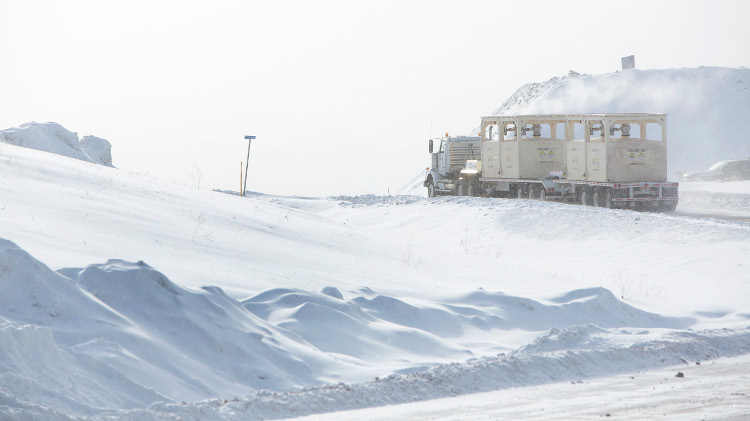 The first truckload of ore leaves for the McClean Lake processing facility in March. Courtesy of Cameco Corp.
The first truckload of ore leaves for the McClean Lake processing facility in March. Courtesy of Cameco Corp.
Aside from finally getting the second-largest uranium deposit in the world into production, the takeaways for Cameco are numerous. Planning, thoughtfulness and preparation are certainly valued more than they were before the first inflow in 2006. But some things cannot be planned for. “Lesson A is never give up,” says Steane. The upshot, in his mind, is that with the right attitude and preparation and, most importantly, with determination, even the most challenging projects are possible.
“It doesn’t scare us off,” Steane says. “It maybe causes us to think carefully, but we’re not going to shy away from the non-routine.”
For the general manager at Cigar Lake, the first production milestone is only the beginning. Lowen is already looking ahead, thinking about the thousands of truckloads still to come. For him, and the 600 other members of the Cigar Lake production team, the next challenge is to make sure the mine can be operated reliably enough to get up to the full production volume of 18 million pounds annually by 2018. “I’m absolutely confident that we’re going to get there,” Lowen says. Then, as if to exemplify the determination and flexibility so often demonstrated on the project, he adds, “It’s just going to take a lot of hard work and adjustment as we go along.”
Jet boring
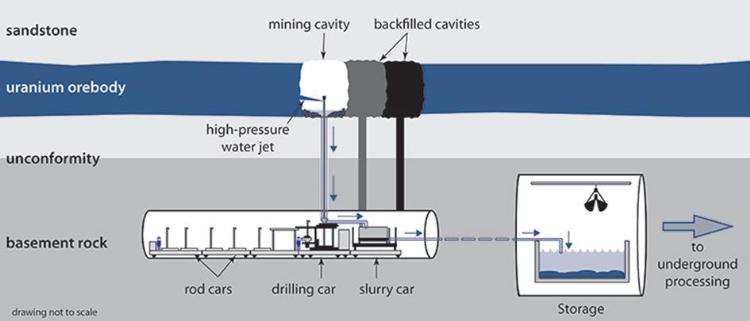
Even before the inflows, Cameco was pioneering innovative techniques to deal with the unique geological conditions and high grade ore at Cigar Lake. The company developed and is now using a non-entry method of mining called jet boring.
From access drifts beneath the frozen ore body, a pilot hole is drilled upwards into the ore. A high-pressure nozzle is inserted into the pilot shaft, and the shaft is sealed. Water jets from the nozzle at 15,000 psi and carves a cavity in the ore body. As the jet circulates around the cavity, rocks breaks off and act as an autogenous mill, grinding the ore further and growing the cavity to an average four to five metres in diameter.
The broken ore flows out of the cavity through steel pipes as slurry. It is pumped to run-ofmine storage and processing equipment, which includes 1,000 cubic metres of ore storage, mills, and a 13-metre diameter thickener, all constructed 480 metres underground with controls to protect workers from radiation from the high-grade ore. After grinding and thickening, the slurry is pumped to the surface to be trucked to Areva’s McClean Lake mill.
The cavity, meanwhile, is back-filled with highstrength concrete, to provide structural stability and to allow mining of adjacent cavities and maximize recovery.
